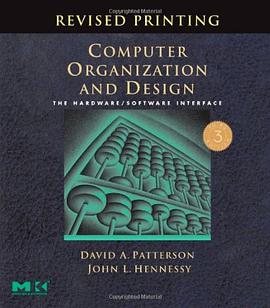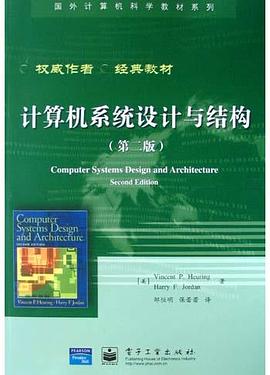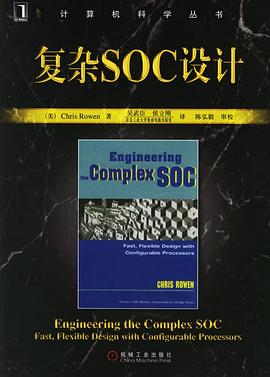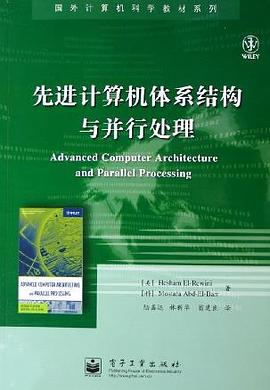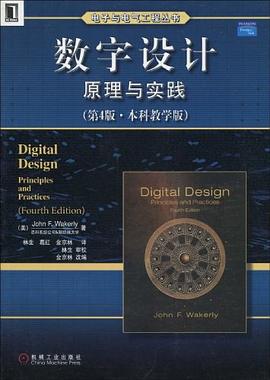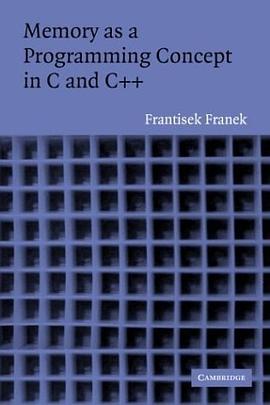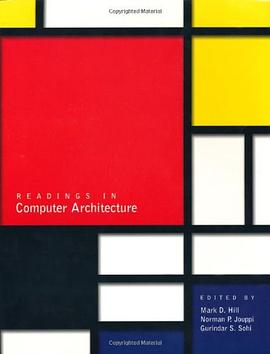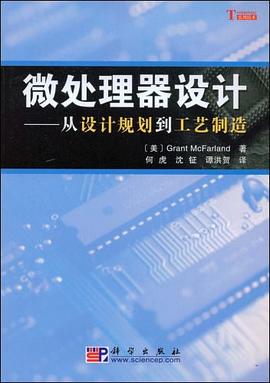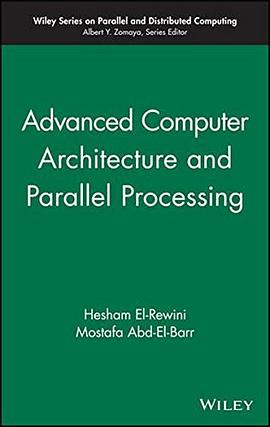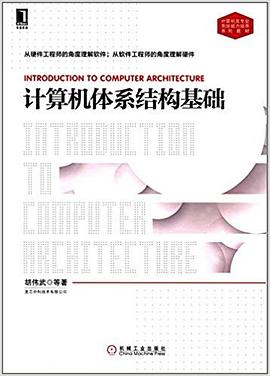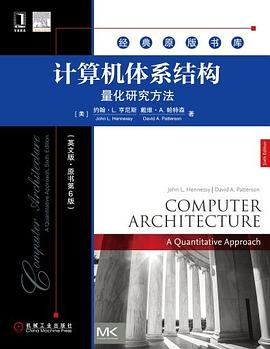

具体描述
在过去20多年的时间里,本书一直是计算机领域的教师、学生和体系结构设计人员的必读之作。两位作者Hennessy和Patterson于2017年荣获图灵奖,肯定了他们对计算机领域持久而重要的技术贡献。随着处理器和系统架构的最新发展,第6版进行了全面修订。这一版采用RISC-V指令集体系结构,这是一个现代的RISC指令集,被设计为免费且可公开采用的标准。书中还增加了一个关于领域特定体系结构的新章节,并更新了关于仓储级计算的章节,其中介绍了谷歌最新的WSC。与本书之前版本的目标一样,本书致力于揭开计算机体系结构的神秘面纱,关注那些令人兴奋的技术创新,同时强调良好的工程设计。
作者简介
John L. Hennessy 斯坦福大学校长,IEEE和ACM会士,美国国家工程研究院院士及美国科学艺术研究院院士。Hennessy教授因为在RISC技术方面做出了突出贡献而荣获2001年的Eckert-Mauchly奖章,他也是2001年Seymour Cray计算机工程奖得主,并且和David A.Patterson分享了2000年约翰 · 冯 · 诺依曼奖。
David A. Patterson 加州大学伯克利分校计算机科学系教授,美国国家工程研究院院士,IEEE和ACM会士。他因为对RISC技术的贡献而荣获1995年IEEE技术成就奖,而在RAID技术方面的成就为他赢得了1999年IEEE Reynold Johnson信息存储奖。2000年他和John L. Hennessy分享了约翰 · 冯 · 诺依曼奖。
目录信息
1.1 Introduction 2
1.2 Classes of Computers 6
1.3 Defining Computer Architecture 11
1.4 Trends in Technology 18
1.5 Trends in Power and Energy in Integrated Circuits 23
1.6 Trends in Cost 29
1.7 Dependability 36
1.8 Measuring, Reporting, and Summarizing Performance 39
1.9 Quantitative Principles of Computer Design 48
1.10 Putting It All Together: Performance, Price, and Power 55
1.11 Fallacies and Pitfalls 58
1.12 Concluding Remarks 64
1.13 Historical Perspectives and References 67
Case Studies and Exercises by Diana Franklin 67
Chapter 2 Memory Hierarchy Design
2.1 Introduction 78
2.2 Memory Technology and Optimizations 84
2.3 Ten Advanced Optimizations of Cache Performance 94
2.4 Virtual Memory and Virtual Machines 118
2.5 Cross-Cutting Issues: The Design of Memory Hierarchies 126
2.6 Putting It All Together: Memory Hierarchies in the ARM Cortex-A53 and Intel Core i7 6700 129
2.7 Fallacies and Pitfalls 142
2.8 Concluding Remarks: Looking Ahead 146
2.9 Historical Perspectives and References 148
Case Studies and Exercises by Norman P. Jouppi, Rajeev
Balasubramonian, Naveen Muralimanohar, and Sheng Li
Chapter 3 Instruction-Level Parallelism and Its Exploitation
3.1 Instruction-Level Parallelism: Concepts and Challenges 168
3.2 Basic Compiler Techniques for Exposing ILP 176
3.3 Reducing Branch Costs With Advanced Branch Prediction 182
3.4 Overcoming Data Hazards With Dynamic Scheduling 191
3.5 Dynamic Scheduling: Examples and the Algorithm 201
3.6 Hardware-Based Speculation 208
3.7 Exploiting ILP Using Multiple Issue and Static Scheduling 218
3.8 Exploiting ILP Using Dynamic Scheduling, Multiple Issue, and Speculation 222
3.9 Advanced Techniques for Instruction Delivery and Speculation 228
3.10 Cross-Cutting Issues 240
3.11 Multithreading: Exploiting Thread-Level Parallelism to Improve Uniprocessor Throughput 242
3.12 Putting It All Together: The Intel Core i7 6700 and ARM Cortex-A53 247
3.13 Fallacies and Pitfalls 258
3.14 Concluding Remarks: What’s Ahead 264
3.15 Historical Perspective and References 266
Case Studies and Exercises by Jason D. Bakos and Robert P. Colwell 266
Chapter 4 Data-Level Parallelism in Vector, SIMD, and GPU Architectures
4.1 Introduction 282
4.2 Vector Architecture 283
4.3 SIMD Instruction Set Extensions for Multimedia 304
4.4 Graphics Processing Units 310
4.5 Detecting and Enhancing Loop-Level Parallelism 336
4.6 Cross-Cutting Issues 345
4.7 Putting It All Together: Embedded Versus Server GPUs and Tesla Versus Core i7 346
4.8 Fallacies and Pitfalls 353
4.9 Concluding Remarks 357
4.10 Historical Perspective and References 357
Case Study and Exercises by Jason D. Bakos 357
Chapter 5 Thread-Level Parallelism
5.1 Introduction 368
5.2 Centralized Shared-Memory Architectures 377
5.3 Performance of Symmetric Shared-Memory Multiprocessors 393
5.4 Distributed Shared-Memory and Directory-Based Coherence 404
5.5 Synchronization: The Basics 412
5.6 Models of Memory Consistency: An Introduction 417
5.7 Cross-Cutting Issues 422
5.8 Putting It All Together: Multicore Processors and Their Performance 426
5.9 Fallacies and Pitfalls 438
5.10 The Future of Multicore Scaling 442
5.11 Concluding Remarks 444
5.12 Historical Perspectives and References 445
Case Studies and Exercises by Amr Zaky and David A. Wood 446
Chapter 6 Warehouse-Scale Computers to Exploit Request-Level and Data-Level Parallelism
6.1 Introduction 466
6.2 Programming Models and Workloads for Warehouse-Scale Computers 471
6.3 Computer Architecture of Warehouse-Scale Computers 477
6.4 The Efficiency and Cost of Warehouse-Scale Computers 482
6.5 Cloud Computing: The Return of Utility Computing 490
6.6 Cross-Cutting Issues 501
6.7 Putting It All Together: A Google Warehouse-Scale Computer 503
6.8 Fallacies and Pitfalls 514
6.9 Concluding Remarks 518
6.10 Historical Perspectives and References 519
Case Studies and Exercises by Parthasarathy Ranganathan 519
Chapter 7 Domain-Specific Architectures
7.1 Introduction 540
7.2 Guidelines for DSAs 543
7.3 Example Domain: Deep Neural Networks 544
7.4 Google’s Tensor Processing Unit, an Inference Data Center Accelerator 557
7.5 Microsoft Catapult, a Flexible Data Center Accelerator 567
7.6 Intel Crest, a Data Center Accelerator for Training 579
7.7 Pixel Visual Core, a Personal Mobile Device Image Processing Unit 579
7.8 Cross-Cutting Issues 592
7.9 Putting It All Together: CPUs Versus GPUs Versus DNN Accelerators 595
7.10 Fallacies and Pitfalls 602
7.11 Concluding Remarks 604
7.12 Historical Perspectives and References 606
Case Studies and Exercises by Cliff Young 606
Appendix A Instruction Set Principles
A.1 Introduction A-2
A.2 Classifying Instruction Set Architectures A-3
A.3 Memory Addressing A-7
A.4 Type and Size of Operands A-13
A.5 Operations in the Instruction Set A-15
A.6 Instructions for Control Flow A-16
A.7 Encoding an Instruction Set A-21
A.8 Cross-Cutting Issues: The Role of Compilers A-24
A.9 Putting It All Together: The RISC-V Architecture A-33
A.10 Fallacies and Pitfalls A-42
A.11 Concluding Remarks A-46
A.12 Historical Perspective and References A-47
Exercises by Gregory D. Peterson A-47
Appendix B Review of Memory Hierarchy
B.1 Introduction B-2
B.2 Cache Performance B-15
B.3 Six Basic Cache Optimizations B-22
B.4 Virtual Memory B-40
B.5 Protection and Examples of Virtual Memory B-49
B.6 Fallacies and Pitfalls B-57
B.7 Concluding Remarks B-59
B.8 Historical Perspective and References B-59
Exercises by Amr Zaky B-60
Appendix C Pipelining: Basic and Intermediate Concepts
C.1 Introduction C-2
C.2 The Major Hurdle of Pipelining—Pipeline Hazards C-10
C.3 How Is Pipelining Implemented C-26
C.4 What Makes Pipelining Hard to Implement C-37
C.5 Extending the RISC V Integer Pipeline to Handle Multicycle Operations C-45
C.6 Putting It All Together: The MIPS R4000 Pipeline C-55
C.7 Cross-Cutting Issues C-65
C.8 Fallacies and Pitfalls C-70
C.9 Concluding Remarks C-71
C.10 Historical Perspective and References C-71
Updated Exercises by Diana Franklin C-71
References R-1
Index I-1
Online Appendices
Appendix D Storage Systems
Appendix E Embedded Systems
by Thomas M. Conte
Appendix F Interconnection Networks
by Timothy M. Pinkston and Jos.e Duato
Appendix G Vector Processors in More Depth
by Krste Asanovic
Appendix H Hardware and Software for VLIW and EPIC
Appendix I Large-Scale Multiprocessors and Scientific Applications
Appendix J Computer Arithmetic
by David Goldberg
Appendix K Survey of Instruction Set Architectures
Appendix L Advanced Concepts on Address Translation
by Abhishek Bhattacharjee
Appendix M Historical Perspectives and References
· · · · · · (收起)
读后感
每一个搞计算机的必读之一,如果想让你的程序运行的快,那么你就读完这本书。 这本书会让你真正的理解什么是cache, cache并不是对程序员是透明的,在编程的时候是需要考虑到的。 这本书需要读至少两遍才能真正体会其中的奥秘。 这本书是我们公司人手必读的一本书之一。
评分本书总的来说还是比较高级的内容,对内存模型,缓存结构方式的概念原理等都略过不讲。专心讲 quantitative 的部分。如果对体系结构不熟悉,应该先读 <Computer Organization and Design > 或者 <Computer Systems: A Programmer's Perspective>。 本书最大的特点就是...
评分最近在关注多核计算机体系结构方面的内容,颇感当年读书不用功,很多基本的东西都忘记了。好在当你读书记住的东西不多,书倒是不少。于是翻箱倒柜的把这本体系结构的圣经给翻了出来。 《计算机体系结构:量化研究方法》不愧是此中的经典,把体系结构层次化的展现出来,同时把...
评分本书总的来说还是比较高级的内容,对内存模型,缓存结构方式的概念原理等都略过不讲。专心讲 quantitative 的部分。如果对体系结构不熟悉,应该先读 <Computer Organization and Design > 或者 <Computer Systems: A Programmer's Perspective>。 本书最大的特点就是...
评分每一个搞计算机的必读之一,如果想让你的程序运行的快,那么你就读完这本书。 这本书会让你真正的理解什么是cache, cache并不是对程序员是透明的,在编程的时候是需要考虑到的。 这本书需要读至少两遍才能真正体会其中的奥秘。 这本书是我们公司人手必读的一本书之一。
用户评价
相关图书
本站所有内容均为互联网搜索引擎提供的公开搜索信息,本站不存储任何数据与内容,任何内容与数据均与本站无关,如有需要请联系相关搜索引擎包括但不限于百度,google,bing,sogou 等
© 2025 book.quotespace.org All Rights Reserved. 小美书屋 版权所有


